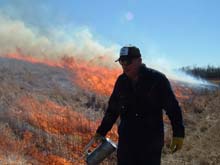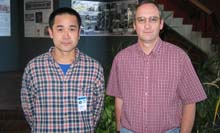 | Thursday, November 10, 2005 |
|
Thursday, November 10 Friday, November 11
Saturday, November 12 |
|
Extended Forecast |
Secon Level 3 |
|
Thursday, November 10 -Santa Fe Black Bean -Sloppy Joe -Stuffed Peppers -Sauteed Liver & Onions -Baked Ham & Swiss on a Ciabatta Roll -California Pizza -Crispy Fried Chicken Ranch Salad Seasonal Changes in the Cafe Menu: There is now a daily oatmeal bar with all of your favorite toppings and chilli will be offered on Monday, Wednesday and Friday each week. The Wilson Hall Cafe accepts Visa, Master Card, Discover and American Express at Cash Register #1. |
|
Thursday, November 10 Dinner BOOKED
Wednesday, November 16
Chez Leon Menu |
| Fermilab Today is online at: http://www.fnal.gov/today/ Send comments and suggestions to today@fnal.gov Fermilab Today archive Hurricane Relief Page Fermilab Today PDF Version Fermilab Result of the Week archive Fermilab Safety Tip of the Week archive Linear Collider News archive Fermilab Today classifieds Subscribe/Unsubscribe to |
| Pierre Auger Observatory
November 10 Press Release |
|
Pierre Auger Observatory Celebrates Progress on Detector Array and Presents First Science Results
MALARGÜE, Argentina -- Scientists of the Pierre Auger Observatory, a project to discover the origins of rare and mysterious ultra-high energy cosmic rays, began a celebration today (10 November) in Malargüe, Argentina, to mark the progress on installation of the Observatory’s detectors on the Argentina Pampas, and the presentation of the first physics results.
"These highest-energy cosmic rays are messengers from the extreme universe. They represent a great opportunity for discoveries," said Nobel Prize winner James Cronin, of the University of Chicago, who conceived the Auger experiment together with Alan Watson of the University of Leeds (UK). Watson added: "How does nature create the conditions to accelerate a tiny particle to such an energy? Tracking these ultrahigh-energy particles back to their sources will answer that question."
|
| Zydeco star C.J. Chenier To Perform this Weekend |
| C.J. Chenier and the Red Hot Louisiana Band will hit the stage on Saturday at 8 p.m. in Ramsey Auditorium. Chenier, who has produced five albums, is regarded as a leading performer of zydeco, a fast-paced blend of music dominated by the accordion. Influenced by his father, zydeco musician Clifton Chenier, C.J. Chenier infuses traditional zydeco with a contemporary punch. "C.J. Chenier attacks the accordion with the tension and drive of James Brown, creating contemporary, turbo-charged dance music," said The Boston Globe. Tickets for the performance are $19 for adults and $10 for those ages 18 and under. For more information call 630-840-2787 or visit the Website. |
Grids and Gluons
"We are striving to understand the fundamental structure of matter," said Abhay Deshpande, a physicist from the State University of New York at Stony Brook. "Protons and neutrons form 99% of the matter around us, and mass and spin are their two fundamental properties."
Spin is the direction a particle spins around an axis as it travels, just as the Earth spins on its axis as it travels around the sun. Until 1989, physicists assumed that the spin of the three quarks that make up a proton combine to create the total proton spin. That year, a European nuclear physics experiment using a method called Deep Inelastic Scattering reported that the three quarks only carry 20–30% of the proton's spin. This result, later confirmed by DIS experiments around the world and labeled the "spin crisis," caused physicists to suspect that the gluons that bind quarks together may be the carriers of the missing spin.
|
|
Press Release, House Committee on Science, November 9, 2005: Boehlert Promises to Kill Fusion Project If Funding Agreement is not Reached WASHINGTON, DC - House Science Committee Chairman Sherwood Boehlert (R-NY) made the following statement today during debate over the Energy and Water appropriations bill: “Mr. Chairman:
|
| R You Standard Model Top? | ||
| ||
|
We have all heard of the word decay and many things come to mind when we think of it. One type of decay is nuclear decay where the nucleus of a radioactive element falls apart into constituent pieces, releasing energy in the process. In the mysterious world of fundamental particles studied at Fermilab, it turns out that the basic building blocks of matter can also decay. For example, the top quark can decay into a bottom quark or other types of quark, releasing energy in the process. This is, at first glance, quite surprising since the top quark is not made of any constituent parts but is a fundamental particle. But despite its fundamental nature, the top quark can decay through quantum mechanical processes to other lighter fundamental particles. The Standard Model of particle physics exactly predicts the specific modes of decay and daughter products. If our understanding of the physics of these elementary particles is incomplete in some way, then it is possible that the top quark could decay in some unanticipated way - which would be a signal for a new type of physics. Since the Tevatron accelerator at Fermilab is the only place in the world where top quarks can currently be produced, scientists from around the world have collaborated to study this particle which only existed in nature shortly after the big bang. Physicists working on the DZero experiment have examined how often a top quark decays to a bottom quark, and how often it decays to other quark species. The b quarks are long lived and can be "tagged" by looking for the b quark decay vertex. Simply put, by finding top quarks and looking for the number of secondary vertices we can tally the number of decays to b quarks and the number of decays to lighter quarks. If the ratio of the number of top quark decays to a bottom quark to the number of top quark decays to any quark (including the bottom quark) is different from 1 (the Standard Model prediction), it would be a sure sign that our understanding of nature was incomplete. As it is, the measured ratio, R = 1.0 ± 0.2, is found to be consistent with the Standard Model prediction. However as the Tevatron continues to produce record amounts of data, the DZero team will be able to more accurately measure this ratio and thereby test the physics of the big bang.
|
||
| ||
| Result of the Week Archive |
| Gollwitzer and Hanagaki Promoted to Scientist I | ||
|
Keith Gollwitzer and Kazu Hanagaki have recently been promoted to Scientist I, an appointment without term limit. Gollwitzer, of the Accelerator Division, first came to Fermilab in 1989 as a graduate student from the University of California, Irvine. He was promoted from Associate Scientist for his role in the Antiproton Source and continued involvement in the analysis for experiment E835. Gollwitzer works on the operations of the accelerator complex, striving to make improvements in the antiproton stacking rate. He also worked earlier on experiment E760. "I hope we can increase the stacking rate," he said. "And I hope the Antiproton Source stays around for future experiments."
Hanagaki, of DZero, joined Fermilab in 2001 as a Wilson Fellow, but spent a few years previously working at the lab as a graduate student from Osaka University. He was promoted for his contributions to DZero, including the silicon system, b-tagging and the Z+b/Z+ jets analysis. Hanagaki said in the future, he looks forward to seeing the new silicon system put to use. "We're working on the silicon detectors now, but we're still waiting for their installation," he said. "Hopefully, that will be next spring.
|
|
November 7 - 9 - Two stores provided 37 hours of luminosity to the experiments. - TeV RF spark caused quench. - Pelletron down for work. - Multiple problems troubles NuMI.
Read the Current Accelerator Update
|
|
Payday Change
Mileage Reimbursement Rate Increase
Hand Drumming Today
International Folk Dancing
|






